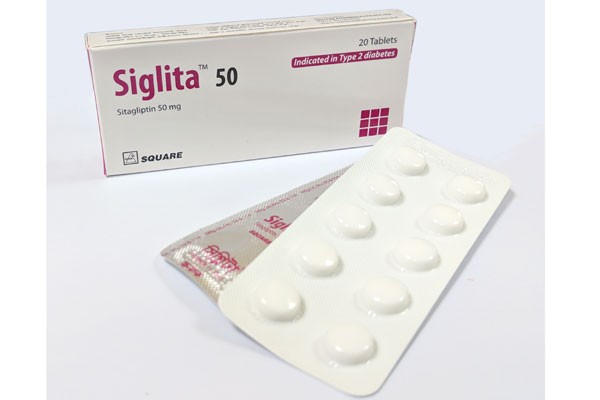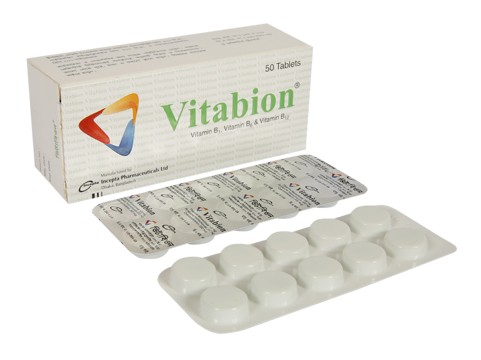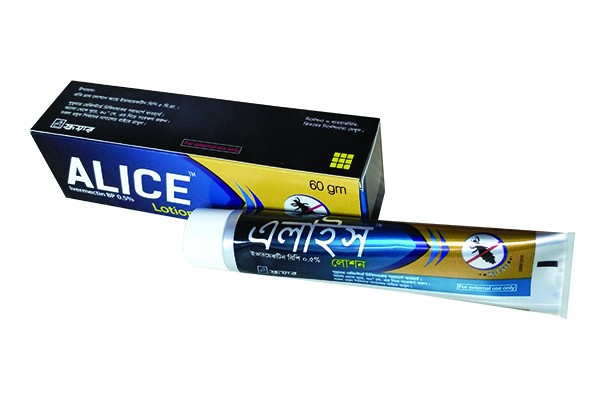

Siglita Tablet 50 mg (10Pcs)
Inhouse product
-
৳1,010.00
৳1,510.00 -
৳10.00
৳12.00 -
৳112.00
৳120.00 -
৳127.00
৳132.00 -
৳110.00
৳138.00
Reviews & Ratings
Indications
Monotherapy: Sitagliptin is indicated as an adjunct to diet and exercise to improve glycemic control in patients with type ll diabetes mellitus.
Combination with Metformin: Sitagliptin is indicated in patients with type 2 diabetes mellitus to improve glycemic control in combination with Metformin as initial therapy or when the single agent alone, with diet and exercise, does not provide adequate glycemic control.
Combination with a Sulfonylurea: Sitagliptin is indicated in patients with type ll diabetes mellitus to improve glycemic control in combination with a sulfonylurea when treatment with the single agent alone, with diet and exercise, does not provide adequate glycemic control.
Combination with a Thiazolidinediones: Sitagliptin is indicated in patients with type ll diabetes mellitus to improve glycemic control in combination with a thiazolidinedi- one when treatment with the single agent alone, with diet and exercise, does not provide adequate glycemic control.
Combination with Metformin and a Sulfonylurea: Sitagliptin is indicated in patients with type ll diabetes mellitus to improve glycemic control in combination with Metformin and a sulfonylurea when dual therapy with these agents, with diet and exercise, does not provide adequate glycemic control.
Therapeutic Class
Dipeptidyl Peptidase-4 (DPP-4) inhibitor
Pharmacology
The DPP-4 inhibitors are a class of agents that act as incretin enhancers. By inhibiting the DPP-4 enzyme, Sitagliptin increases the levels of two known active incretin hormones, glucagon-like peptide-1 (GLP-1) and glucose-dependent insulinotropic polypeptide (GIP). The incretins are part of an endogenous system involved in the physiologic regulation of glucose homeostasis. When blood glucose concentrations are normal or elevated, GLP-1 and GIP increase insulin synthesis and release from pancreatic beta cells. GLP-1 also lowers glucagon secretion from pancreatic alpha cells, leading to reduced hepatic glucose production. This mechanism is unlike the mechanism seen with sulfonylureas; sulfonylureas cause insulin release even when glucose levels are low, which can lead to sulfonylurea-induced hypoglycemia in patients with type ll diabetes and in normal subjects. Sitagliptin demonstrates high selectivity for DPP-4 and does not inhibit closely-related enzymes DPP-8 or DPP-9 at therapeutic concentrations.
Dosage & Administration
The recommended dose of Sitagliptin is 100 mg once daily as monotherapy or as combination therapy with Metformin, a sulfonylurea, a thiazolidinedione, or Metformin plus a sulfonylurea. Sitagliptin can be taken with or without food.
Elderly: No dosage adjustment is required based solely on age. The drug is excreted by the kidney. As elderly patients are more likely to have decreased renal function, caution should be taken in dose selection in the elderly.
Pediatric use: There is no data on use of Sitagliptin in patients younger than 18 years of age and therefore not recommended.
Interaction
Co-administration of Digoxin and Sitagliptin may slightly increase the mean peak drug concentration of Digoxin. But no dosage adjustment of Digoxin or Sitagliptin is recommended.
Contraindications
History of a serious hypersensitivity reaction to Sitagliptin, such as anaphylaxis or angioedema.
Side Effects
The most common adverse reactions are; upper respiratory tract infection, nasopharyngitis and headache. Hypoglycemia may occur in patients treated with the combination of Sitagliptin and sulfonylurea and add-on to insulin.
Pregnancy & Lactation
Pregnancy: Pregnancy Category B. Safety of Sitagliptin in pregnant women has not been established. Sitagliptin should be used during pregnancy only if the potential benefit justifies the potential risk of the fetus.
Nursing Mothers: It is not known whether Sitagliptin is excreted in human milk. Because many drugs are excreted in human milk, caution should be exercised when Sitagliptin is administered to a nursing woman.
Precautions & Warnings
Sitagliptin should not be used in patients with type l diabetes or for the treatment of diabetic ketoacidosis. Dosage adjustment is recommended in patients with moderate or severe renal insufficiency and in patients with ESRD. Assessment of renal function is recommended prior to initiating Sitagliptin and periodically thereafter. When used with a sulfonylurea, a lower dose of sulfonylurea may be required to reduce the risk of hypoglycemia. There have been post marketing reports of serious allergic and hypersensitivity reactions in patients treated with Sitagliptin such as anaphylaxis, angioedema, and exfoliative skin conditions including Stevens-Johnson syndrome. In such cases, promptly stop Sitagliptin, assess for other potential causes, and institute appropriate monitoring and treatment, and initiate alternative treatment for diabetes. There have been no clinical studies establishing conclusive evidence of macrovascular risk.
Use in Special Populations
Renal Insufficiency-
Mild renal insufficiency (creatinine clearance [CrCl] >50 mL/min, approximately corresponding to serum creatinine levels of >1.7 mg/dL in men and >1.5 mg/dL in women), no dosage adjustment for Sitagliptin is required.
Moderate renal insufficiency (CrCl >30 to 1.7 to 1.5 to
Severe renal insufficiency (CrCl 3.0 mg/dL in men and > 2.5 mg/dL in women) or with end -stage renal disease (ESRD) requiring hemodialysis or peritoneal dialysis, the dose of Sitagliptin is 25 mg once daily. Sitagliptin may be administered without regard to the timing of hemodialysis. Concomitant Use with a Sulfonylurea- When Sitagliptin is used in combination with a sulfonylurea, a lower dose of sulfonylurea may be required to reduce the risk of hypoglycemia.
Hepatic Insufficiency: No dosage adjustment is necessary for patients with mild to moderate hepatic insufficiency. Sitagliptin has not been studied in patients with severe hepatic insufficiency.
Overdose Effects
During controlled clinical trials in healthy subjects, single doses of up to 800 mg sitagliptin were administered. Minimal increases in QTc, not considered to be clinically relevant, were observed in one study at a dose of 800 mg sitagliptin. There is no experience with doses above 800 mg in clinical studies. In Phase I multiple-dose studies, there were no dose-related clinical adverse reactions observed with sitagliptin with doses of up to 600 mg per day for periods of up to 10 days and 400 mg per day for periods of up to 28 days.
In the event of an overdose, it is reasonable to employ the usual supportive measures, e.g., remove unabsorbed material from the gastrointestinal tract, employ clinical monitoring (including obtaining an electrocardiogram), and institute supportive therapy if required.
Sitagliptin is modestly dialysable. In clinical studies, approximately 13.5 % of the dose was removed over a 3- to 4-hour hemodialysis session. Prolonged haemodialysis may be considered if clinically appropriate. It is not known if sitagliptin is dialysable by peritoneal dialysis.
Storage Conditions
Keep out of the reach of children. Store below 30° C. Keep in the original package in a cool & dry place in order to protect from light and moisture.
Frequently Bought Products
-
৳1,010.00
৳1,510.00 -
৳10.00
৳12.00 -
৳112.00
৳120.00 -
৳127.00
৳132.00 -
৳110.00
৳138.00
Online Shopping Bangladesh : MShopBD-Majumder Shop
MShopBD-Majumder Shop Online Shopping in Bangladesh is the Best Shopping store within 10000+ products cash on delivery in dhaka, Khulna, ctg & all over Bangladesh with COD-cash on delivery (Only Shipping Cost Advance ) under by www.esdp.gov.bd (bangladesh.gov.bd ) Home Delivery all Over Bangladesh different location and shop as like as Multivendor Online Sites in BD.







